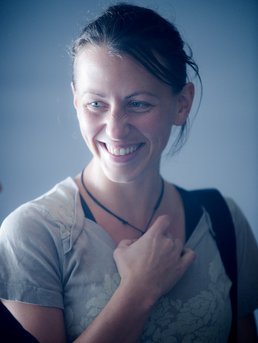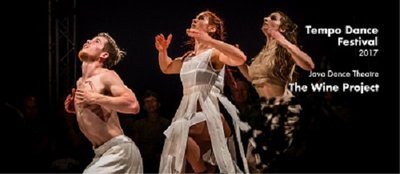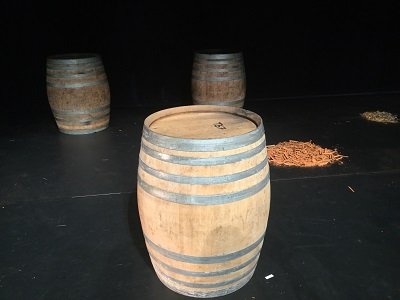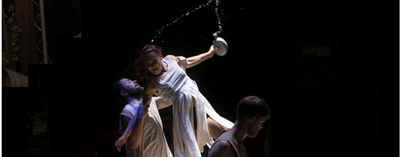
Sacha Copland interviewed by Anastasia Bakogianni
AB: Having been privileged to attend one of Java Dance’s performances of 'The Wine Project', I would love to know more about what inspired you to produce this dynamic and sensual dance piece, in particular of course your "classical" influences.
SC: I did a lot of research on wine before choreographing the show. I read widely, including researching the role of wine in ancient mythology, worked with vintners and experimented. Barrels, grapes and wine have been around for so long that it seemed natural to me to turn to classical mythology for inspiration. My findings led me to focus on the sensual physicality of cultivating and enjoying wine, but another aspect that interested me was the power dynamics and the conflicts it brings to the fore. My creative process involves doing a lot of research, digesting it, and then allowing it to colour rather than dictate my choreography.

AB: Dionysus was the god of wine in ancient Greek mythology and wine and the drinking of wine lies at the heart of 'The Wine Project'. But the ecstatic states produced by wine are balanced in your piece by moments of calm and reflection. Did Friedrich Nietzsche’s influential theory of two clashing impulses governing the arts, the Apollonian versus Dionysian principles, shape your creative process?
SC: Yes, this was one of my key influences. We created half the characters in the Apollonian mould and the other half in the Dionysian and this set up a natural tension between these two opposing forces. It also reinforced the power dynamics that I wanted my piece to explore. If you give dancers clear motivation, magical things happen on stage, and we found the opposition between Apollo and Dionysus very useful. I am really interested in such oppositions and the idea that everything contains within it its opposite. I use this concept both as a physical choreographic principle – the opposing forces in the piece – as well as for the purposes of narrative and characterization. In a dance show, dynamic tension is essential, and the clash between Apollo and Dionysus proved ideal for our work in 'The Wine Project'. I also wanted the characters to swap sides over the course of the show to demonstrate that people are not fixed but malleable and changeable, and this added greatly to the dynamic tension of the work.
AB: One of my favourite elements of attending 'The Wine Project' was how the performance engaged the senses, not just sight and hearing but also taste, smell and touch. Can you tell us more about your creative process and how and why you sought to create this multi-sensory world?
SC: For me, dance is about how the audience experience sensation in their own bodies, as well as what the dancers feel as they perform. Dance is a visceral form of art that is experienced, rather than a purely visual form. Dance has always been associated with harvest festivals, celebrations, and other communal rituals. These were and continue to be multi-sensory experiences that I want to recreate for my audiences, especially nowadays, when we tend to privilege vision over all the other senses. In our modern society we are obsessed with screens, but dance is all about the body, so our bodies have to be involved. All my work aims at achieving, in different ways, this goal, and wine was wonderful to work with for that very reason. The power of our sense of smell, in particular, kept coming up. Wine is after all aromatic and associated with the use of spices.

AB: In many respects the effect of watching 'The Wine Project' is like attending an ancient ritual; almost like a modern Bacchanalia. Was that something you consciously sought to achieve?
SC: I believe that we need more of this kind of communal ritual in our contemporary world. I am convinced that dance can and indeed should provide it. Dance is among the most ancient of rituals that has delighted audiences for millennia.
AB: Ancient theatre-goers were a rowdy bunch by all accounts, but modern theatre audiences tend to be well-behaved and largely passive. But during performances of the 'The Wine Project' you deliberately set out to engage the audience, draw them in, and make them part of the event. Can you tell us more about your approach and the reasons behind it?
SC: I think theatre has become too visual and not holistic enough. New Zealand audiences, in particular, are quite reserved. Growing up in New Zealand and creating much of my work here has made me think a lot about what local audiences might need or indeed crave from a dance show. I think communal tactile sensory engagement is really needed in our arts scene, and it is one of my most cherished goals to offer it in a non-threatening, but, at the same time, provocative way.

AB: Do classical connections make an appearance in some of your other works? Tell us more.
SC: The classical influences are most obvious in 'The Wine Project'. 'The Creamery' (the next piece in my Artisan Series) feels more like a Romeo and Juliet story, and in my research for this project I explored mob mentality. Using chocolate as my anchor I started with a contemporary setting, but ended up going back to an ancient land of drumming, earth-rites and dancing. I am very interested in origin stories, which is why I am fascinated by classical mythology. The Artisan Series explores the concept of civilisation from a New Zealand perspective and engages with our old myths. In other words, it seeks to examine the belief systems that underpin our society.
AB: What about the future? Do you think the ancient world might continue to be a source of inspiration for you?
SC: I very much hope so, as I love researching and engaging with the past. I am fascinated by anthropology and by how people and civilisations have evolved over time. I believe that we have to be aware of the whole of human history rather than focusing only on the Industrial Revolution and its aftermath (including our own modern technical revolution). Our history, taken as a whole, reveals different aspects of human nature, so it is an endless source of inspiration for me.